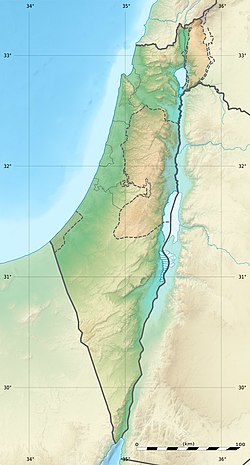Council of Jamnia
| Part of a series on the |
| Bible |
|---|
 |
|
Outline of Bible-related topics |
The Council of Jamnia (presumably
The theory of a council of Jamnia that finalized the canon, first proposed by Heinrich Graetz in 1871,[5] was popular for much of the 20th century. However, it has been increasingly questioned since the 1960s onward, and the theory has now been largely discredited.[6]
Background
The
The theory

The Mishnah, compiled at the end of the 2nd century, describes a debate over the status of some books of Ketuvim, and in particular over whether or not they render the hands "impure"[clarification needed]. Yadaim 3:5 calls attention to a debate over Song of Songs and Ecclesiastes. The Megillat Taanit, in a discussion of days when fasting is prohibited but that are not noted in the Bible, mentions the holiday of Purim. Based on these, and a few similar references, Heinrich Graetz concluded in 1871 that there had been a Council of Jamnia (or Yavne in Hebrew) which had decided the Jewish canon sometime in the late 1st century (c. 70–90).[8]
Refutation
W. M. Christie was the first to dispute this popular theory in an article entitled "The Jamnia Period in Jewish History".
Albert C. Sundberg Jr. summarized the crux of Lewis' argument as follows:
Jewish sources contain echoes of debate about biblical books but canonicity was not the issue and debate was not connected with Jabneh... Moreover, specific canonical discussion at Jabneh is attested only for Chronicles and Song of Songs. Both circulated prior to Jabneh. There was vigorous debate between Beth
Ben Sira is mentioned by name in rabbinic sources and it continued to be circulated, copied and cited. No book is ever mentioned in the sources as being excluded from the canon at Jabneh.[14]
According to Lewis:
The concept of the Council of Jamnia is an hypothesis to explain the canonization of the Writings (the third division of the Hebrew Bible) resulting in the closing of the Hebrew canon. ...These ongoing debates suggest the paucity of evidence on which the hypothesis of the Council of Jamnia rests and raise the question whether it has not served its usefulness and should be relegated to the limbo of unestablished hypotheses. It should not be allowed to be considered a consensus established by mere repetition of assertion.
The 20th-century evangelical scholar F. F. Bruce thought that it was "probably unwise to talk as if there were a Council or Synod of Jamnia which laid down the limits of the Old Testament canon."[15] Other scholars have since joined in and today the theory is largely discredited.[1][2][3] Some hold that the Hebrew canon was established during the Hasmonean dynasty (140–40 BCE).[16]
References
- ^ a b Jack P. Lewis (2002). "Jamnia Revisited". In L. M. McDonald; J. A. Sanders (eds.). The Canon Debate.
- ^ ISBN 0830819754.
- ^ a b Jack P. Lewis (1964). "What Do We Mean by Jabneh?". Journal of Biblical Literature. 32: 125–130.
- ^ Edward W. Klink III (2008), "Expulsion from the synagogue? Rethinking a Johannine Anachronism", Tyndale Bulletin. Accessed 28 May 2016
- ^ Kohelet oder der Salomonische Prediger: Ubersetzt und Kritisch Erläutert, Leipzig 1871, pp. 147–173.
- ^ L. M. McDonald & J. A. Sanders (eds.), The Canon Debate, Peabody (Mass.), Hendrickson Publishers, 2002, chapter 9: "Jamnia Revisited" by Jack P. Lewis, pp. 146–162.
- ^ Talmud Gittin 56a–b, p. 95, Kantor
- ^ Graetz, Heinrich (1871). "Der alttestamentliche Kanon und sein Abschluss (The Old Testament Canon and its finalisation)". Kohélet, oder der Salomonische Prediger (Kohélet, or Ecclesiastes) (in German). Leipzig: Carl Winters Universitätsbuchhandlung. pp. 147–173.
- ^ The Journal of Theological Studies, vol. 26, July 1925, pp. 347–364.
- ^ Journal of Bible and Religion, Vol. 32, No. 2 (April 1964), pp. 125–132.
- ^ The Canonization of Hebrew Scripture: The Talmudic and Midrashic Evidence, New York, Anchor Books, 1976.
- Anchor Bible DictionaryVol. III, pp. 634–7 (New York 1992).
- ^ Lim, Timothy H. (2010) "The Defilement of the Hands as a Principle Determining the Holiness of Scriptures", in: The Journal of Theological Studies 61(1) DOI:10.1093/jts/flq079 2010
- ^ Albert C. Sundberg Jr. (1997). Thomas J. Sienkewicz; James E. Betts (eds.). "The Old Testament of the Early Church Revisited". Festshchrift in Honor of Charles Speel. Monmouth, Illinois: Monmouth College.
- ISBN 9780830812585.
- ^ Philip R. Davies in The Canon Debate, page 50: "With many other scholars, I conclude that the fixing of a canonical list was almost certainly the achievement of the Hasmonean dynasty."
Sources
- Kantor, Mattis, The Jewish timeline encyclopaedia: a year-by-year history from Creation to the present day, Jason Aronson Inc., Northvale N.J., 1992
External links
- Robert C. Newman, 'The Council of Jamnia and the Old Testament Canon' (1983), an in-depth discussion of the subject on the site of the Interdisciplinary Biblical Research Institute.
- Bob Stanley, 'The Deuterocanonicals' (2002), an interpretation of "The Council of Jamnia" presented on the website of The Catholic Treasure Chest.
- Jamina or ( Jabneh ) at JewishEncyclopedia.com
- Jewish Encyclopedia: Academy of Jabneh
- Jewish Encyclopedia: Birkat ha-Minim
- Jewish Encyclopedia: Min
- "The Old Testament of the Early Church" Revisited, Albert C. Sundberg, Jr., 1997


